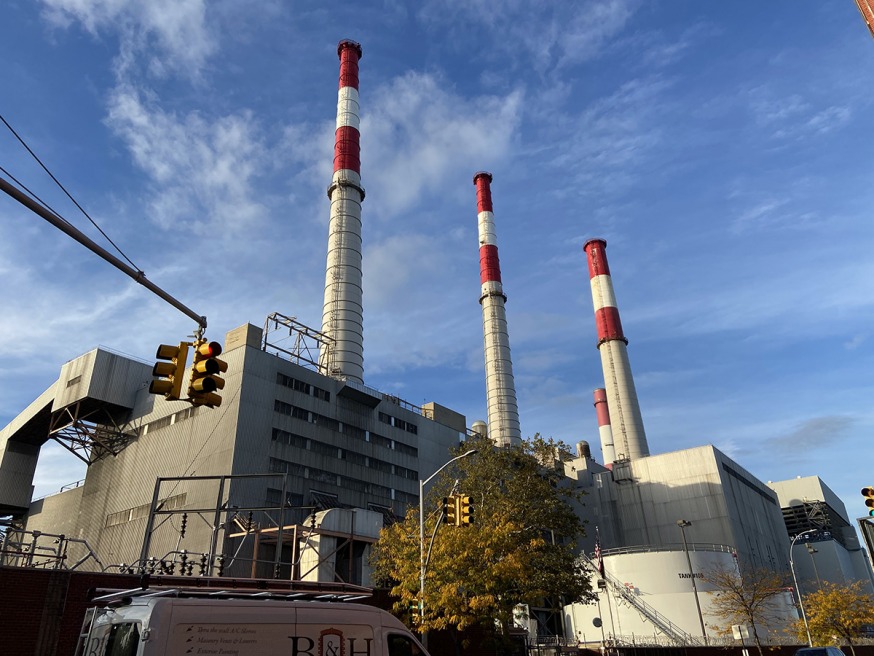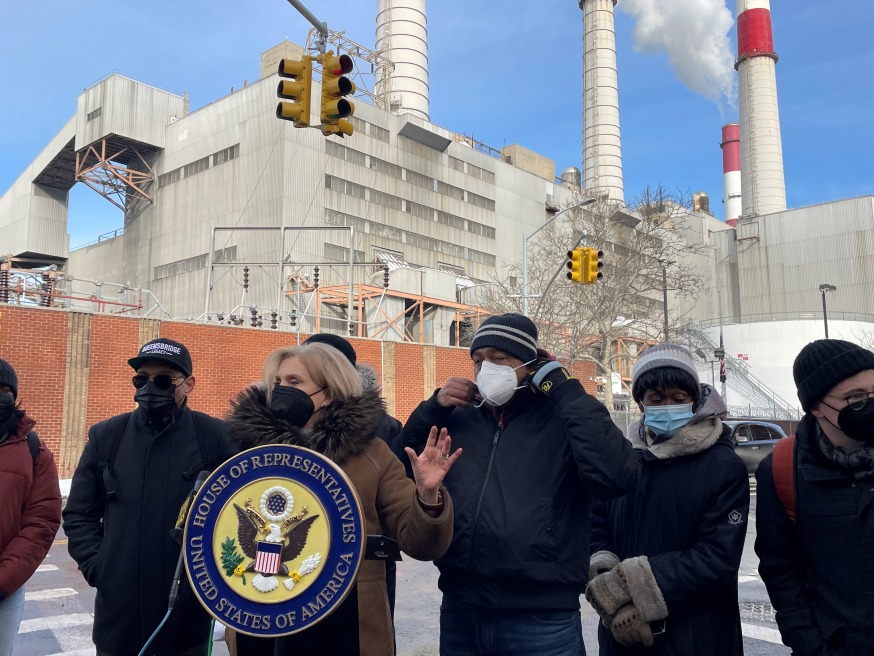
The Ravenswood Generating Station located at 38-54 Vernon Blvd. in Long Island City (Photo: Ta’Leah Van Sistine/Queens Post)
Feb. 7, 2022 By Christian Murray
The operators of the Ravenswood Generating Station—home to the infamous red-and-white “Big Allis” smokestack in Long Island City—came under fire yet again last week.
Congresswoman Carolyn Maloney held a press conference outside the Ravenswood power plant on Vernon Boulevard Jan. 31, as part of her quest to have the fossil-fuel generating facility shut down—along with many power plants like it.
She announced that she is introducing a bill called the Justice in Power Plant Permitting Act, a bill that would prevent the issuance of new permits to fossil-fuel energy providers that pollute communities. The bill aims to advance the transition to clean energy.
The event was held outside the Ravenswood Generating Station, Maloney said, since it is the largest and most toxic power plant in New York City. Ravenswood is one of several power plants located along the Astoria/Long Island City waterfront, which has led to elevated pollution levels and its nickname “Asthma Alley.”
“We are in a climate emergency,” Maloney said. “To combat it, we must recognize that two generations of residents right here in Asthma Alley have been subjected to unending toxic pollution. The air pollution coming from Ravenswood has inflicted asthma, heart disease, and cancer on this community! This is a crisis of environmental justice, and it must be stopped.”
Ravenswood Generating Station is owned by Rise Light & Power, which took over the plant in 2017. The 27-acre plant is located across the street from Queensbridge Houses, the largest NYCHA development in North America with 3,142 apartments. It is also near Ravenswood Houses, a NYCHA complex that includes 2,167 units, and Astoria Houses, a NYCHA development with 1,102 apartments.
Rise Light & Power, in response to the criticism, says that it also wants to transition away from fossil fuels and plans to turn its facility into a renewable energy hub.
Clint Plummer, CEO of Rise Light & Power, said that since the company took control of the plant it has taken steps to reduce its carbon footprint. It has closed 16 of its 17 peaker plants, with a plan to close its 17th at the beginning of 2023. Peaker plants, experts say, are notoriously toxic and are used when demand for power is high.
Plummer said that the company will have reduced its capacity from 2,500 megawatts to 2,000 megawatts upon closing its final peaker plant. It also plans to install 300 megawatts of battery storage, he added.
The company has four main generators at the Ravenswood station producing the 2,000 megawatts, with Big Allis generating about half of those megawatts. The power at the Ravenswood plant is primarily generated by natural gas supplied by Con Edison—although oil is used as a backup when the system is stretched during peak demand.
There are two large tanks that contain oil on site, and there are barges on the East River that are used to supply them. The plant does not use coal.
Plummer said that the company released a plan in 2021 that would have seen 1,200 megawatts of electricity generated by renewable energy sources. The plan, called the Catskills Renewable Connector, would have brought solar and wind power through an underwater cable from upstate New York through to the plant.
More than 1,000 NYCHA residents at Queensbridge, Ravenswood and Astoria Houses signed a petition in support of the plan.
The project, one of seven evaluated by the New York State Energy Research and Development Authority as part of a request for proposals to connect the five boroughs to renewable energy sources, lost to two other projects—the Champlain Hudson Power Express and Clean Path New York.
Plummer said that Rise Light & Power is now working on coming up with other plans that rely on renewable energy.
“Our plan is to work with the city and the state to over time transition this site to become a hub for clean energy. And to do that, we need support for projects like Catskills that will allow us to bring new sources of energy into the site. Catskills was the first of those that we had proposed. However, there are several other exciting projects in the works that we will be bringing forward publicly in coming months.”
The transition from fossil fuels to renewable energy sources will be incremental and take time, Plummer said.
“There’s not a single project out there that is going to—in one fell swoop—transition Ravenwood [Generating Station] from what it is today into a clean energy hub. It will take a lot of work over a number of years.”

Congresswoman Carolyn Maloney holds a press conference outside Big Allis on Jan. 31 to announce her Justice in Power Plant Permitting Act (Photo:@RepMaloney)
Maloney, however, wants it shut now—given the pollution levels. She has been campaigned for years to close the fossil fuel plants along the waterfront, describing it as a matter of environmental justice.
Maloney’s bill, if passed, would also stop the permitting of fossil fuel-fired plants within one mile of a major pollution source if the combined effects would cause harm to the health and well-being of local communities.
The legislation would also establish a Just Energy Transition Fund for clean energy projects that support workers and environmental justice.
The bill also calls on the federal government to work with the energy sector to ensure that all power generation is renewable—and air pollution-free— by 2030.
Plummer did not comment on Maloney’s legislation, other than saying, “We are still reviewing it.”
Maloney’s federal legislation comes at a time when New York State is clamping down on fossil fuel plants. The state has placed strict pollution limits on peaker plants, which will result in many having to close in 2023.
Additionally, the 2019 passage of the Climate Leadership and Community Protection Act requires the state to supply 70 percent of its electricity from renewable sources by 2030—and 100 percent by 2040.
Plummer said the state has a long way to go to meet these targets. Currently, he said, around 80 percent of New York City’s electricity needs are still generated by fossil fuels.
Plummer said Rise Light & Power supports the movement away from fossil fuels and that the company is committed to the transition.
“We see the effects of climate change on a frighteningly frequent basis now,” Plummer said. “It’s very clear that we have to do something, and the technology is there.”
Happening Now: Join me w/ NYCHA Residents’ Association Leadership & climate justice advocates to intro my Justice in Power Plant Permitting Act which will crack down on polluting plants that have resulted in generations of W. Queens residents becoming sick https://t.co/1fCkHkJKto
— Carolyn B. Maloney (@RepMaloney) January 31, 2022
